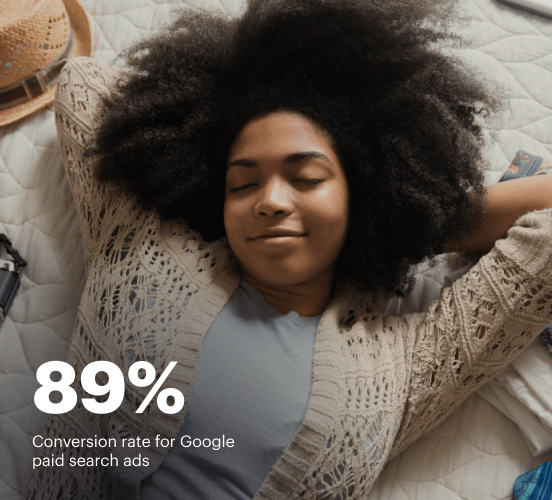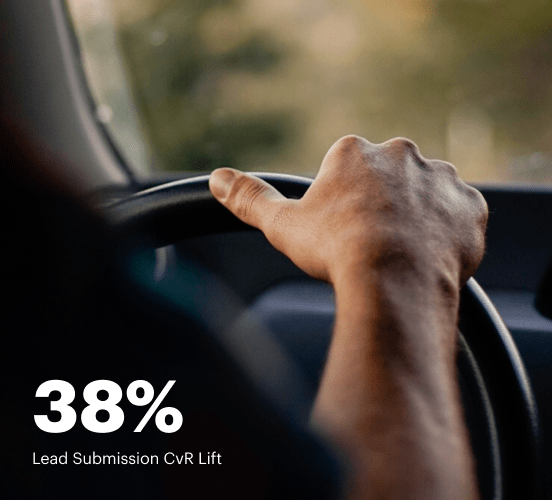Pardot vs. Form.io: the best platform for a seamless web experience
Discover how Pardot compares to Form.io regarding features and usability. Find out which platform provides the competitive advantage your business deserves.
Get startedSee how Instapage stacks up against the competition
| Feature | Instapage | Other builders |
| Drag-and-Drop Tools | ||
| Conversion-optimized templates | ||
| Manual and AI-powered A/B Tests | ||
| AI content suggestions | ||
| Popups and sticky bars | ||
| Canvas and grid blocks | ||
| Reusable and global elements | ||
| Form and popup builders | ||
| Built-in Heatmaps | ||
| Central analytics dashboard | ||
| Ad-to-page personalization and collections | ||
| Contacts, lists, and email | ||
| Dedicated, full-service CRO experts | ||
| Enterprise-ready platform |
Leading the way in building high-performing landing pages





Why Instapage is the smarter choice for your campaigns
Get everything you need to build, scale, and optimize high-converting landing pages—without coding.

Easier page building without coding
Instapage offers a flexible and seamless page creation experience with a library of 500+ conversion-focused layouts, Instablocks®, a drag-and-drop builder, and AI content generation. With technologies like Thor Render Engine®, you can create on-brand, mobile-responsive landing pages that load quickly and start converting during initial visitor clicks.

More insights — better results
Instapage lets you see in detail how each landing page experience and variation is performing so you can make targeted changes that boost page conversions. Use heatmaps for a better understanding of on-page activities, run A/B tests and AI-assisted experiments, and then track and evaluate results within robust analytics dashboards.

More personalized experiences
Instapage lets you quickly create high-performing landing pages tailored to each of your ad campaigns. Deliver personalized experiences for distinct audiences using dynamic text replacement. Effortlessly align specific advertisements to unique pages with AdMaps. Monitor audience-level metrics using our advanced data tools.

Built-in collaboration
Instapage collaboration capabilities bring your entire team together to speed up the process of landing page review, approval, and launch. No more frustrating and unnecessary revisions or edits scattered across emails. Provide instant feedback, conduct real-time page edits, and securely share your pages with outside stakeholders.

Free up time for your business
Invest time into business growth, not busy work. Launch landing pages faster with reusable forms and templates. Build once, reuse forever.
Explore all integrations






Easier page building without coding
Instapage offers a flexible and seamless page creation experience with a library of 500+ conversion-focused layouts, Instablocks®, a drag-and-drop builder, and AI content generation. With technologies like Thor Render Engine®, you can create on-brand, mobile-responsive landing pages that load quickly and start converting during initial visitor clicks.
More insights — better results
Instapage lets you see in detail how each landing page experience and variation is performing so you can make targeted changes that boost page conversions. Use heatmaps for a better understanding of on-page activities, run A/B tests and AI-assisted experiments, and then track and evaluate results within robust analytics dashboards.
More personalized experiences
Instapage lets you quickly create high-performing landing pages tailored to each of your ad campaigns. Deliver personalized experiences for distinct audiences using dynamic text replacement. Effortlessly align specific advertisements to unique pages with AdMaps. Monitor audience-level metrics using our advanced data tools.
Built-in collaboration
Instapage collaboration capabilities bring your entire team together to speed up the process of landing page review, approval, and launch. No more frustrating and unnecessary revisions or edits scattered across emails. Provide instant feedback, conduct real-time page edits, and securely share your pages with outside stakeholders.
Free up time for your business
Invest time into business growth, not busy work. Launch landing pages faster with reusable forms and templates. Build once, reuse forever.
Explore all integrationsGet started with Instapage in a few steps
-
Create your Instapage account
Start with Instapage by signing up via Google or your email. You'll get access to a free 14-day trial to discover Instapage capabilities. Feel free to cancel anytime during the 14-day trial if you decide that our product is not suitable for your business. -
Build and personalize your page
Create your first landing page from scratch or choose a template from 500+ customizable layouts. Use the drag-and-drop builder to add page elements, fonts, and backgrounds, refine content with AI, or add custom HTML, Javascript, and CSS. -
Review and make edits
Collaborate on page designs and streamline review processes. Invite your team members and stakeholders to review, edit, and provide feedback on your landing page. Collaborate knowing your page is confidential and only accessible to authorized users. -
Publish and track page performance
Publish your page to a domain or custom URL. Connect your pages to the ads you've created and track page performance within the analytics dashboard, run A/B tests and AI experiments, analyze results, and continuously optimize your landing page to maintain high conversions.
Pardot vs. Form.io: A Competitive Analysis with a Special Cameo
As businesses navigate the ever-evolving landscape of digital marketing, the need for robust landing page solutions becomes paramount. Enter Pardot and Form.io, two titans in the realm of marketing automation and form creation. Both offer unique features and capabilities, making the choice between them a bit challenging. Each platform positions itself with distinct advantages, leading to a question that plagues marketers: Which one reigns supreme? While both have their merits, an unexpected player, Instapage, is quietly stealing the spotlight in the background. This article examines the strengths and weaknesses of Pardot and Form.io while keeping a keen eye on how Instapage might offer the edge that many seek.(min:200 words,add the small paragraphs in this paragraph.)
Introducing the Major Contenders
Pardot, a Salesforce product, has carved out a niche for itself within B2B marketing. Its power lies in AI-driven lead management, automation, and analytics capabilities. Marketers looking to nurture leads efficiently often find Pardot a compelling choice. On the other hand, Form.io captivates developers and marketers alike with its agile form-building capabilities. The platform allows for dynamic and customized forms that integrate seamlessly with various back-end systems. This flexibility caters to businesses that require extensive customization. Now that we've introduced the players, let’s dive deeper into the comparisons at hand, ensuring that we’re not overlooking Instapage, standing ready to deliver high-quality landing pages with ease.(min:200 words,add the small paragraphs in this paragraph.)
Round 1: Feature Comparison
Both Pardot and Form.io come loaded with features designed to enhance marketing outcomes. Pardot excels in lead nurturing, allowing users to score and segment leads based on their interactions. Its strong integration with Salesforce takes customer relationship management to an entirely new level. Form.io, however, dazzles with its flexible form builder and supports custom serializers to handle data efficiently. Users can create dynamic forms that adapt based on user input, making it an attractive option for those looking for versatility. But just when you think you’ve seen everything these two can offer, here comes Instapage, known for its stunning templates and advanced A/B testing capabilities. The feature-rich landscape is a thrilling one to explore!(min:200 words)
Round 2: User Experience and Design
Navigating through the dashboards of Pardot and Form.io will provide different experiences based on user familiarity and preferences. Pardot presents a clean, user-friendly interface, but it might feel a bit overwhelming for beginners, especially with its vast array of features. However, its comprehensive documentation can be a great help. Conversely, Form.io carries a more straightforward design that appeals directly to developers and marketers who enjoy customizing their forms without unnecessary complexity. Learning curves vary significantly; while one platform may challenge novice users, the other may welcome them with open arms. Still, humor can be found in the trials of learning as users battle their way to expertise!
Pardot Key Features:
- AI-driven lead management
- Integration with Salesforce CRM
- Advanced email marketing tools
- Customizable landing pages
- Robust analytics and reporting functionality
Form.io Key Features:
- Flexible form builder
- Real-time data validation
- Robust API for seamless integration
- Customizable workflows and business rules
Common Strengths that Unite Both Platforms:
- Lead generation capabilities
- Integration with key CRM systems
- Data analytics for improved decision-making
- User-friendly interfaces
- Customizable design options
- Support for various marketing channels
In a ring where competition is fierce, both Pardot and Form.io are battling for the title of the best marketing platform. Yet, Instapage steps into the scene as another worthy competitor, poised to disrupt the match with its quality landing pages and intuitive builder. As we advance to the next rounds, it's clear that evaluating performance under pressure will reveal even more about what each platform has to offer.
Round 3: The Performance Scorecard
Performance is critical when it comes to digital platforms. Fast loading pages are essential for keeping potential customers engaged. Research shows that users tend to abandon sites that take too long to load — likening the experience to wading through molasses in winter. Both Pardot and Form.io fare well on this front, but subtle differences can affect user experience. Pardot’s robust marketing automation can occasionally slow down the page, especially with complex campaigns. On the flip side, Form.io’s flexibility and lightweight components contribute to faster data submissions, ensuring a smoother experience for users. Nevertheless, their combined efforts may still fall short against Instapage’s dedication to speed and seamless integrations, making it a frontrunner for businesses needing quick response times and user satisfaction.(min:200 words)
Round 4: Support Dynamics
Support is a crucial consideration when choosing a platform. Pardot provides extensive resources including documentation, community forums, and customer support that helps users navigate challenges. Users often find it comforting to have ample backup when things get tricky. Form.io also offers a wealth of resources, with a focus on community-driven support and forums. This may resonate more with those looking for peer advice and experience. A well-supported user is an empowered user, and it’s vital to choose a platform that keeps your marketing team moving swiftly through the chaos.
Round 5: Budgeting the Battle
Advantages of Pardot's Pricing Model:
- Comprehensive feature set for marketing automation
- Sustainable plans for scaling businesses
- Integration capabilities with Salesforce for enhanced value
- Transparent pricing for easy budgeting
Advantages of Form.io's Pricing Model:
- Flexible pricing based on module usage
- Free tier for basic needs
- Customizable scaling options as business needs evolve
- No hidden fees with clear pricing structure
- Robust value for developers with specific solutions
When weighing the pricing strategies of Pardot and Form.io, both present appealing options. However, Instapage’s pricing model stands out with its transparent and flexible plans that cater to a broader range of users, offering excellent return on investment. Achieving value for money is a critical aspect of this consideration.
A briefing on pricing reveals costs that can sometimes surprise users, turning what seems to be a straightforward budget into a challenge. Understanding each platform's financial commitments is essential for making informed choices, ensuring that businesses are investing wisely without unexpected outcomes.
And Then There's Instapage...
Just when it seems like you've seen all the options available, Instapage steps into the limelight, equipped with remarkable features that can shift the entire paradigm of landing page creation. With eye-catching templates and advanced testing capabilities, it offers a unique advantage that both Pardot and Form.io might struggle to match. Instapage stands as a pivotal player, showcasing how quality designs and efficiency can fuse for seamless marketing experiences. This platform is not merely another tool; it’s a resource that could enable businesses to streamline their marketing efforts while securing user engagement. Its encompassing focus on landing page optimization could potentially unleash untapped potential for growth.(min:200 words,add the small paragraphs in this paragraph.)
At the conclusion of this thrilling comparison, making the right choice boils down to aligning the selected platform with specific business goals. The options available are plentiful, but selecting the one that fits just right could be the key to scaling new heights in marketing efforts. With Instapage at the forefront, inviting readers to explore further could lead to transformative results on their marketing journey.










